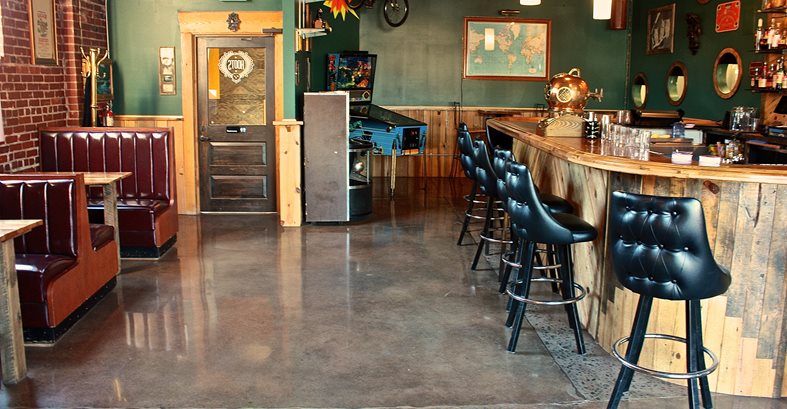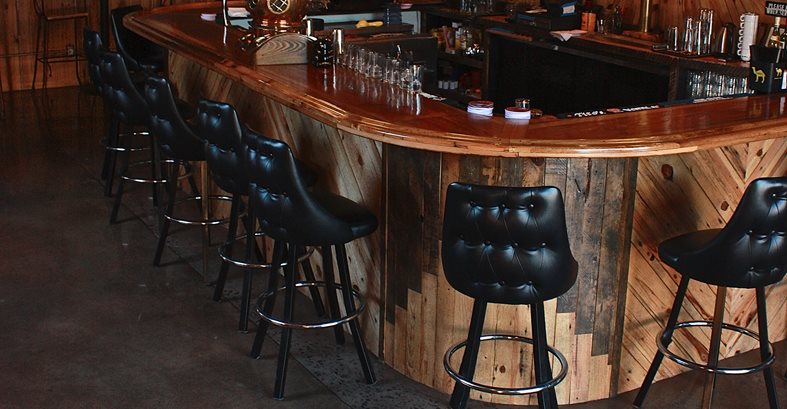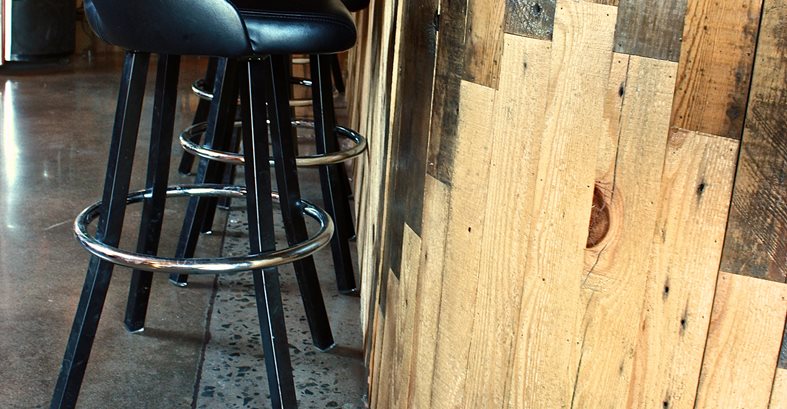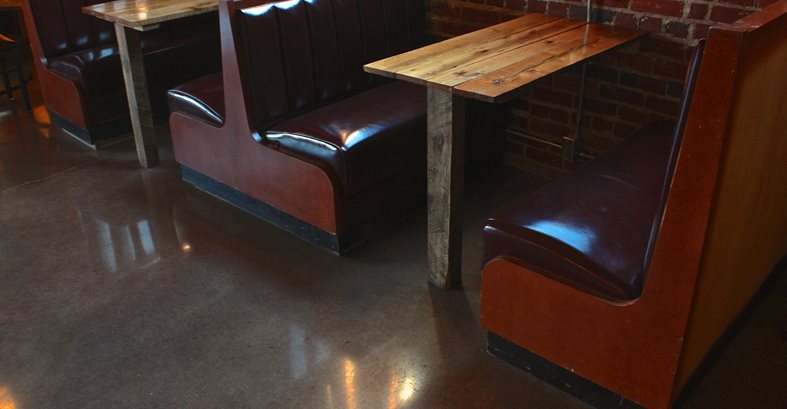- Polished Concrete Information
- Polished Concrete Pictures
- What is Polished Concrete
- Polished Concrete Cost
- Design Ideas for Polished Concrete
- Polished Concrete Maintenance
- Common Questions about Polished Concrete
- Can All Concrete be Polished?
- Comparison Chart: Polished concrete versus other flooring materials
- What are Polished Overlays?
- Polishing Products and Equipment: An overview of basic equipment and supplies needed
- Related Information
- Information About: Concrete Floors
- Concrete Contractors: Find Concrete Polishing Products and Suppliers
- Design Ideas: Polished Concrete Info
Polishing and Dye Give Brewery Floor Historic Character
Project submitted by Tyler Reed, Perfection Plus Concrete Polishing, Kernersville, N.C.The name of Hoots Roller Bar and Brewery in Winston-Salem, N.C., is rooted in history, as is the original decades-old concrete floor in the building, which was recently restored to serve a new purpose.
The brewery is named after the Hoots family, the owners of the roller mill that once occupied the space and was a primary flour producer in North Carolina in the early 1900s. The bar and brewery now occupy part of what used to be a 17,000-square-foot grist mill.
"When Hoots Roller Bar and Brewery co-founders Eric Swaim and Ryan Pritz asked us about helping with flooring design, we were honored to be a part of this historic project," says Tyler Reed of Perfection Plus Concrete Polishing. "The age of the concrete in the mill gave us a challenge at first. It was poured over 80 years ago, and as is often the case with old concrete, was very inconsistent and uneven."
The owners wanted to maintain a rustic atmosphere in the bar, which has tables, walls and ceilings made of reclaimed lumber and stained woodwork. They also wanted an easy-to-maintain floor that would stand up to the heavy traffic and spills that are inevitable in a busy bar and brewery.
"They wanted something that would continue to look good without having to spend lots of money on topical sealers and maintenance every year," says Reed. "I showed them some pictures of recent jobs where we'd used three colors to make an antiqued look with a lot of character that would complement the earthy atmosphere in their bar."
The owners not only liked the look and character of polished concrete, they also chose it for practical reasons. "They thought of installing wood flooring, but the slab was so uneven it would have taken a fair amount of resurfacing to prep for the install and would have been too costly. They also didn't like the idea of how dirty grout could get if they installed tile," says Reed.
The project involved polishing and dyeing 1,300 square feet of concrete in the corner of the building, where several different pours merged together. "There were many patches and inconsistent areas from the different tenants and machinery in the space over the last half century. So before the polishing could begin, we had to hand grind the joints where uneven slabs met and take parts of the overall slab down a half inch," says Reed.
Once they polished the floor down to a uniform surface, the crew applied dyes to the concrete, using a rustic color combination of leather, saddle brown and black. They also filled all the joints in the floor with a matching brown polyurea joint filler. After dye application, they treated the floor with a concrete densifier and let it sit overnight to lock in the color. The next day, they came back and continued to polish the floor up to a 3,000-grit finish and applied two coats of penetrating sealer, buffing in between coats with a high-speed propane burnisher equipped with a diamond-impregnated pad. As a final protective barrier, they applied two coats of an oil and water repellent to resist stains and spills.
The newly restored floor now has a mirror-like finish in a beautiful blend of colors that complement the bar interior and maintain the building’s historic character. The floor will also last for many more decades to come with minimal maintenance.
"We gave Hoots a concrete floor cleaner for regular maintenance and suggested that we come back twice a year to do a high-speed buff to restore the gloss," says Reed. "The owners and customers have been very pleased with the results, and it's been nice to see how well the floors are holding up in such a harsh environment."
Equipment and materials used
Polishing equipment: G-320D PRO grinder from Concrete Polsihing Solutions; Diamond tooling from HTC Professional Floor Systems
Buffing equipment: Amano Pioneer Eclipse propane burnisher; HTC diamond-impregnated buff pad
Concrete dye: Scofield Formula One in leather, AmeriPolish SureLock in saddle brown and black
Polyurea joint filler: Metzger/Mcguire Spal-Pro RS 88 in Brevity Brown
Concrete densifier: Xtreme Hard, from Xtreme Polishing Systems
Penetrating sealer: Xtreme Shield
Oil and water repellent: Stand Off SLX100, from Prosoco
Polishing contractor
Perfection Plus Inc., Kernersville, N.C.
Submit Your Own Project Photos
Learn more about using concrete for brewery floors








